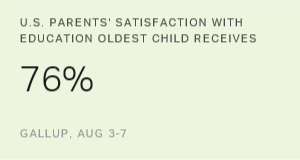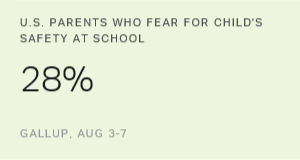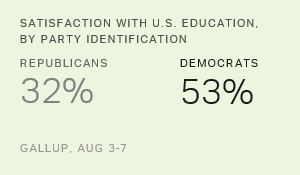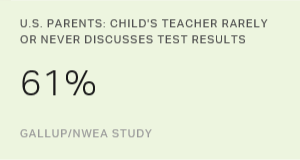Story Highlights
- 36% of parents are completely satisfied with oldest child's education
- Private school parents far more satisfied than public school parents
- Little difference in educational satisfaction by race or income
PRINCETON, N.J. -- As U.S. schoolchildren head back to the classroom, a Gallup review of 16 years of data from its education polls yields five insights into parents' satisfaction with their own children's education.
While three in four parents are broadly satisfied with the education their oldest child receives, less than half as many -- 36% -- say they are completely satisfied. This finding is largely consistent with parental attitudes since Gallup began tracking the question in 2001, spanning the implementation of both No Child Left Behind in 2002, and Common Core, implemented in most states around 2013.

Large majorities of all major racial, income and political subgroups of U.S. parents are at least somewhat satisfied with the education their oldest child is receiving. However, the rest of this analysis focuses on the percentages of U.S. parents who feel completely satisfied, as that is where most variation across subgroups is seen. The data are drawn from the combined results from Gallup's Education and Work surveys conducted each August since 2001.
About 12% of U.S. school parents report that their oldest child attends a private (defined as private or parochial) school. Since 2001, an average of 62% of these private school parents say they are completely satisfied with their oldest child's education, compared with just 28% of public school parents. Further, there is no difference within these categories by household income. Sixty-two percent of high-income and medium- to low-income private school parents say they are completely satisfied. Likewise, just 20% of high- and medium- to low-income public school parents are completely satisfied. Despite the greater choice that high-income parents presumably have in where to live or what private school to use, the act of choosing a private school seems to matter more than household income, per se.
| All parents | High-income parents | Medium-/Low-income parents | |||||||||||||||||||||||||||||||||||||||||||||||||||||||||||||||||||||||||||||||||||||||||||||||||
|---|---|---|---|---|---|---|---|---|---|---|---|---|---|---|---|---|---|---|---|---|---|---|---|---|---|---|---|---|---|---|---|---|---|---|---|---|---|---|---|---|---|---|---|---|---|---|---|---|---|---|---|---|---|---|---|---|---|---|---|---|---|---|---|---|---|---|---|---|---|---|---|---|---|---|---|---|---|---|---|---|---|---|---|---|---|---|---|---|---|---|---|---|---|---|---|---|---|---|---|
| % | % | % | |||||||||||||||||||||||||||||||||||||||||||||||||||||||||||||||||||||||||||||||||||||||||||||||||
| Child in public school | 28 | 29 | 28 | ||||||||||||||||||||||||||||||||||||||||||||||||||||||||||||||||||||||||||||||||||||||||||||||||
| Child in private school | 62 | 62 | 62 | ||||||||||||||||||||||||||||||||||||||||||||||||||||||||||||||||||||||||||||||||||||||||||||||||
| Combined 2001-2016 data. High-income defined as $75,000+ annually; medium-/low-income defined as less than $75,000 annually. | |||||||||||||||||||||||||||||||||||||||||||||||||||||||||||||||||||||||||||||||||||||||||||||||||||
| Gallup | |||||||||||||||||||||||||||||||||||||||||||||||||||||||||||||||||||||||||||||||||||||||||||||||||||
On average since 2001, nearly identical percentages of Republican and Democratic parents have said they are completely satisfied with their oldest child's education. However, this average masks a shift over time. In the eight years that George W. Bush was president, from 2001 through 2008, Republican parents were more satisfied than Democratic parents, 32% vs. 24%. The pattern then flipped during the eight years of Barack Obama's presidency, with 30% of Democratic parents vs. 24% of Republican parents feeling completely satisfied. This likely reflects the normal pattern of Republicans and Democrats feeling more positive about government agencies and government job performance when the president is from their own party.
| Since 2001 | 2001-2008 | 2009-2016 | |||||||||||||||||||||||||||||||||||||||||||||||||||||||||||||||||||||||||||||||||||||||||||||||||
|---|---|---|---|---|---|---|---|---|---|---|---|---|---|---|---|---|---|---|---|---|---|---|---|---|---|---|---|---|---|---|---|---|---|---|---|---|---|---|---|---|---|---|---|---|---|---|---|---|---|---|---|---|---|---|---|---|---|---|---|---|---|---|---|---|---|---|---|---|---|---|---|---|---|---|---|---|---|---|---|---|---|---|---|---|---|---|---|---|---|---|---|---|---|---|---|---|---|---|---|
| % | % | % | |||||||||||||||||||||||||||||||||||||||||||||||||||||||||||||||||||||||||||||||||||||||||||||||||
| Republican/Lean Republican | 28 | 32 | 24 | ||||||||||||||||||||||||||||||||||||||||||||||||||||||||||||||||||||||||||||||||||||||||||||||||
| Democrat/Lean Democratic | 27 | 24 | 30 | ||||||||||||||||||||||||||||||||||||||||||||||||||||||||||||||||||||||||||||||||||||||||||||||||
| Gallup | |||||||||||||||||||||||||||||||||||||||||||||||||||||||||||||||||||||||||||||||||||||||||||||||||||
On average since 2001, there has been no difference in parents' satisfaction with their oldest child's education according to race. However, mirroring the differences seen by party, a slightly higher percentage of black parents have said they are completely satisfied during the eight years of Obama's presidency, whereas white parents were a bit more satisfied than blacks during the eight years of George W. Bush's presidency.
| Since 2001 | 2001-2008 | 2009-2016 | |||||||||||||||||||||||||||||||||||||||||||||||||||||||||||||||||||||||||||||||||||||||||||||||||
|---|---|---|---|---|---|---|---|---|---|---|---|---|---|---|---|---|---|---|---|---|---|---|---|---|---|---|---|---|---|---|---|---|---|---|---|---|---|---|---|---|---|---|---|---|---|---|---|---|---|---|---|---|---|---|---|---|---|---|---|---|---|---|---|---|---|---|---|---|---|---|---|---|---|---|---|---|---|---|---|---|---|---|---|---|---|---|---|---|---|---|---|---|---|---|---|---|---|---|---|
| % | % | % | |||||||||||||||||||||||||||||||||||||||||||||||||||||||||||||||||||||||||||||||||||||||||||||||||
| Whites | 28 | 29 | 27 | ||||||||||||||||||||||||||||||||||||||||||||||||||||||||||||||||||||||||||||||||||||||||||||||||
| Blacks | 29 | 25 | 33 | ||||||||||||||||||||||||||||||||||||||||||||||||||||||||||||||||||||||||||||||||||||||||||||||||
| Gallup | |||||||||||||||||||||||||||||||||||||||||||||||||||||||||||||||||||||||||||||||||||||||||||||||||||
There is some difference in public school parents' satisfaction according to the grade level of their oldest child, with 34% of elementary parents (grades K through five) completely satisfied compared with 25% of middle school (grades six through eight) and high school (grades nine through 12) parents. By contrast, there is no meaningful difference in the satisfaction of parents with children in private school according to the school level being rated.
| Grades K-5 | Grades 6-8 | Grades 9-12 | |||||||||||||||||||||||||||||||||||||||||||||||||||||||||||||||||||||||||||||||||||||||||||||||||
|---|---|---|---|---|---|---|---|---|---|---|---|---|---|---|---|---|---|---|---|---|---|---|---|---|---|---|---|---|---|---|---|---|---|---|---|---|---|---|---|---|---|---|---|---|---|---|---|---|---|---|---|---|---|---|---|---|---|---|---|---|---|---|---|---|---|---|---|---|---|---|---|---|---|---|---|---|---|---|---|---|---|---|---|---|---|---|---|---|---|---|---|---|---|---|---|---|---|---|---|
| % | % | % | |||||||||||||||||||||||||||||||||||||||||||||||||||||||||||||||||||||||||||||||||||||||||||||||||
| Child in public school | 34 | 25 | 25 | ||||||||||||||||||||||||||||||||||||||||||||||||||||||||||||||||||||||||||||||||||||||||||||||||
| Child in private school | 62 | 59 | 63 | ||||||||||||||||||||||||||||||||||||||||||||||||||||||||||||||||||||||||||||||||||||||||||||||||
| Gallup | |||||||||||||||||||||||||||||||||||||||||||||||||||||||||||||||||||||||||||||||||||||||||||||||||||
Bottom Line
Over the past two decades, the public schools have been the laboratory for one education reform effort after another, but all have focused, to some degree, on raising the educational attainment of the most disadvantaged students. Perhaps because of this focus, and regardless of the statistics about test scores, low-income parents are no less satisfied than high-income parents with the quality of the education their own child is receiving.
A much bigger predictor of how satisfied parents are with the quality of their oldest child's education is whether the student attends a public or private school. That is largely to be expected, in that private school parents have made a deliberate decision about what school their child attends, and they are free to change it if they aren't satisfied. It may also reflect something unique about private schools, whether that be a high quality of education, smaller class size, more parent involvement or greater symmetry between the parents' and school's values.
Meanwhile, despite significant federal and state-level focus on education reform in the past decade and a half, public school parents are no more satisfied today than they were in 2001 with the quality of their own child's education. Parental satisfaction is not necessarily indicative of students' academic performance, but one might expect some improvement for all the effort that policymakers are putting into the system. The good news is that the vast majority of public school parents are at least somewhat satisfied with their child's education. The continuing challenge is that far fewer are completely satisfied. And given the high satisfaction expressed by private school parents, it's clear that higher parental satisfaction with their child's schooling is possible, and possibly worth striving for.
Historical data are available in Gallup Analytics.
Survey Methods
Results for this analysis are based on aggregated data from Gallup's 2001 through 2016 Work and Education polls, conducted each August with approximately 1,000 national adults, including approximately 250 parents of children in kindergarten through grade 12.
For annual results based on all K-12 school parents, the margin of sampling error is ±8 percentage points at the 95% confidence level.
For 2001-2016 combined results of 3,594 public school parents, the margin of sampling error is ±2 percentage points at the 95% confidence level. For 2001-2016 combined results of 608 private (including parochial) school parents, the margin of sampling error is ±5 percentage points at the 95% confidence level. All reported margins of sampling error include computed design effects for weighting. Subgroups of these combined samples are associated with larger margins of error.
Learn more about how the Gallup Poll Social Series works.




